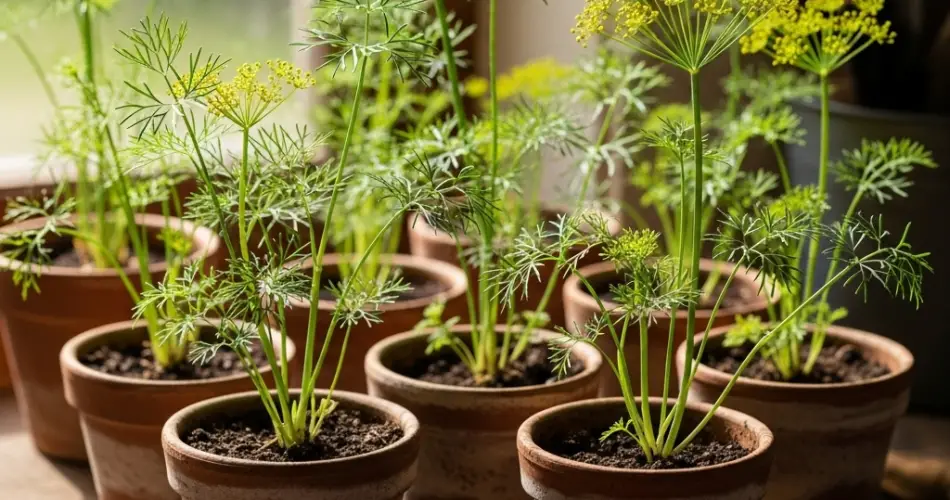Dill is a popular herb known for its feathery green foliage and fresh, tangy flavor that elevates everything from fish dishes to pickles. While it’s often grown in garden beds, dill can also thrive in small pots, making it accessible for anyone with limited outdoor space. However, one common challenge container gardeners face is keeping dill upright. The plant’s tall, slender stems are prone to leaning or falling over, especially in small pots where root systems have limited room to anchor.
Fortunately, with the right approach, you can enjoy strong, upright dill plants in containers. By paying attention to pot size, soil, light, water, and support, you’ll ensure healthy growth and a steady supply of this aromatic herb.
Choose the Right Container
The first step to upright dill is choosing an appropriately sized pot. Although dill can grow in relatively small containers, it has a long taproot that needs depth to stabilize the plant. A minimum depth of 12 inches is recommended, even if the pot isn’t wide. If the pot is too shallow, the roots won’t be able to anchor properly, causing stems to flop over.
For small-space gardeners, narrow but deep pots are ideal. A container with good drainage holes is also essential to prevent root rot, which weakens the plant’s foundation.
Use Well-Draining Soil
The type of soil you use plays a big role in how well dill stands tall. Dill prefers light, well-draining soil that allows roots to grow straight and deep. A mix of regular potting soil with sand or perlite works best. Avoid heavy soils that stay wet for too long, as this creates weak root systems and unstable plants.
Fill the container almost to the top, leaving about two inches of space from the rim. This ensures there’s enough soil volume for strong roots while making watering easier.
Provide Adequate Sunlight
Dill is a sun-loving herb that thrives in 6–8 hours of direct sunlight per day. Without enough light, plants become leggy and weak, which makes them prone to falling over.
Place your pot in the sunniest spot you can find, such as a south-facing balcony, patio, or window. If you’re growing dill indoors, consider supplementing with a grow light. Keep the light about 6–8 inches above the plants and run it for 12–14 hours daily to mimic natural sunlight. Strong light leads to thicker stems and sturdier growth.
Watering for Strength
Watering correctly is another factor in keeping dill upright. Overwatering can weaken the plant’s root system, while underwatering causes stress and brittle growth. The key is to maintain consistent soil moisture.
-
Check soil about an inch down; if it feels dry, it’s time to water.
-
Water thoroughly until liquid drains from the bottom of the pot.
-
Avoid leaving water sitting in saucers, as soggy soil encourages root problems.
In hot weather, you may need to water daily, while cooler conditions may require less frequent watering. Balanced hydration helps the plant develop strong roots, which in turn provide upright support.
Support Tall Stems
Even with the best care, dill’s tall stems can still become floppy in small pots. Providing support ensures the plant stays upright and healthy.
-
Stakes: Insert a thin bamboo stick or wooden skewer near the base of the plant. Use soft ties, twine, or even strips of fabric to gently secure the stems to the stake.
-
Cages: A small tomato cage or homemade wire ring can surround the plant, giving stems something to lean against as they grow.
-
Grouping: Growing multiple dill plants close together allows them to support each other naturally, reducing the need for extra stakes.
Support should be provided early before the stems bend, as it’s harder to correct once they’ve already fallen over.
Fertilize Lightly
Dill doesn’t require heavy feeding, but potted plants may benefit from occasional fertilizer since nutrients wash away with watering. Apply a balanced liquid fertilizer once every 3–4 weeks during the growing season. Too much fertilizer, however, can cause soft, weak growth that bends easily. Feeding lightly helps strengthen stems without overstimulating fragile tissue.
Harvesting for Stability
Regular harvesting not only provides you with fresh dill but also encourages sturdier plants. Snip off fronds from the outer parts of the plant once it reaches about 8 inches tall. Avoid taking more than one-third of the plant at a time. By trimming regularly, you prevent dill from becoming top-heavy, which helps it stay upright in small pots.
If you want dill seeds, allow one or two stems to flower while continuing to harvest the others. This balances the plant’s energy between seed production and leafy growth, keeping it from collapsing under the weight of too many flowers.
Common Problems and Fixes
-
Flopping stems: Usually caused by shallow pots or lack of light. Use deeper containers and ensure adequate sunlight.
-
Weak, leggy growth: A sign of insufficient light or over-fertilization. Adjust light exposure and reduce feeding.
-
Root rot: Prevent by ensuring proper drainage and avoiding soggy soil.
Final Thoughts
Keeping dill upright in small pots takes a little planning, but it’s entirely achievable. Choose a deep container, use well-draining soil, provide plenty of sunlight, water consistently, and add support if needed. With these steps, your dill plants will stand tall and strong, rewarding you with a steady supply of fragrant leaves and seeds.
Whether you’re seasoning soups, garnishing seafood, or making homemade pickles, your container-grown dill will be fresh, flavorful, and beautifully upright right outside your kitchen door.



